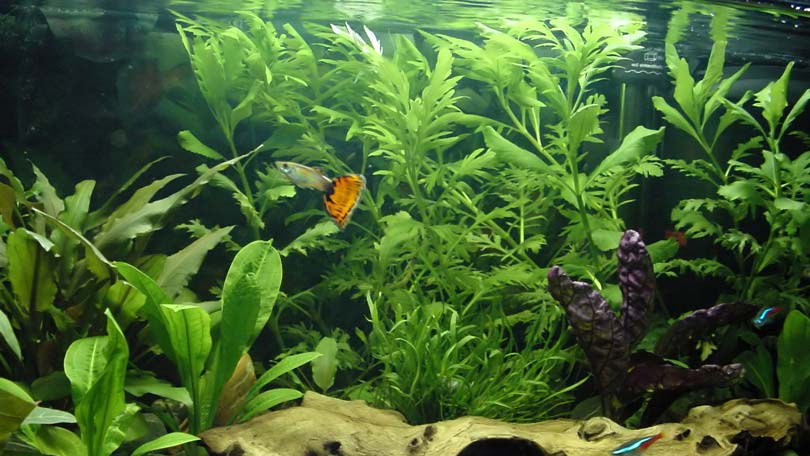
While artificial plants are certainly plentiful there are numerous advantages to adding live plants to your aquarium. Perhaps the biggest advantage to adding live plants comes from the supply of oxygen. Oxygen is essential to the biological system of your aquarium inhabitants. Through the process known as photosynthesis the live plants will utilize the carbohydrates from inorganic substances, like carbon dioxide and water, and release oxygen as a by-product. The symbiotic relationship of the fish providing toxic waste for the plants to feed off of and the plants returning the favor of providing oxygen is beneficial for both the plants and the fish.
When planning to add live plants to your aquarium it is important to understand that live plants typically do not fare well in aquariums which have been newly established. This is because nitrates, a substance that plants use in the photosynthesis process, are relatively low in newly established aquariums.
To keep your live plants healthy you will need to keep an eye on them to determine whether they need any nutrient additives. As your tank ages, the live plants will tend to use up abundant levels of nitrates. Your plants will also need iron for healthy growth. By monitoring the color of your plants, you will be able to know whether you need to add nutrients. For example, green plants which tend to become yellow quickly may be exhibiting signs of iron deficiency. A good plant additive will contain phosphates, iron, nitrates and other nutrients which will keep your plants healthy and thriving.
Lighting is another essential element of the photosynthesis process; necessary for both healthy fish and live plants. If you have a planted aquarium, it is recommended to maintain a ten to twelve hour light cycle. The strength of lighting you need will largely depend on the size of your aquarium; however, two watts of lighting per gallon is a good rule of thumb to ensure sufficient plant growth.
Water hardness and pH levels should also be monitored with an aquarium featuring live plants. Water hardness is the level of minerals present in the water. Levels range between hard, a high degree of minerals, and soft; a low degree of minerals. A simple test kit can help you to measure your water hardness. Most tropical plants come from waters where the level of hardness is 8 degrees or less.
The pH level refers to the potential of hydrogen in the water. This ranges from low (acidic) to high (alkaline) or neutral. You will need to measure the pH level according to the particular type of plants kept in your aquarium. Generally, plants will do well in lower to slightly higher than neutral water. Test kits are also available which will help you to monitor the pH levels of your water.
When it comes time to actually plant your live plants, there are several different techniques which can be used. The appropriate technique will depend on the species you intend to use. Plants which require a substrate should be combined with a course sand or fine gravel. Other plants will grow roots and will not require a substrate; however. Other plants will even attach to rocks, so it is important to know which type of plant species you are using.
Plants should be removed from their bunch, with each strand planted separately. The leaves should be pulled down to the section where the leaf connects to the stem first. This will allow the stem to grow roots. Once this is done the plant stems can either be planted in order for them to sprout in the substrate or allowed to float in the aquarium for a few days to allow roots to develop.
Keep in mind that bare root plants should be planted just like outdoor plants. A hole should be placed in the substrate that is large enough to accommodate the roots. Gently place the roots in the hole and spread them out; carefully covering the roots with just enough substrate to keep them from floating away. Take care not to push the crown of the plant below the ground surface as this can cause damage to the plant. If you are using plant species which will root on rocks and root, the plant base can simply be attached to the base using a bit of fishing line. After the plant roots have grown and become securely attached, carefully snip away the fishing line.




























